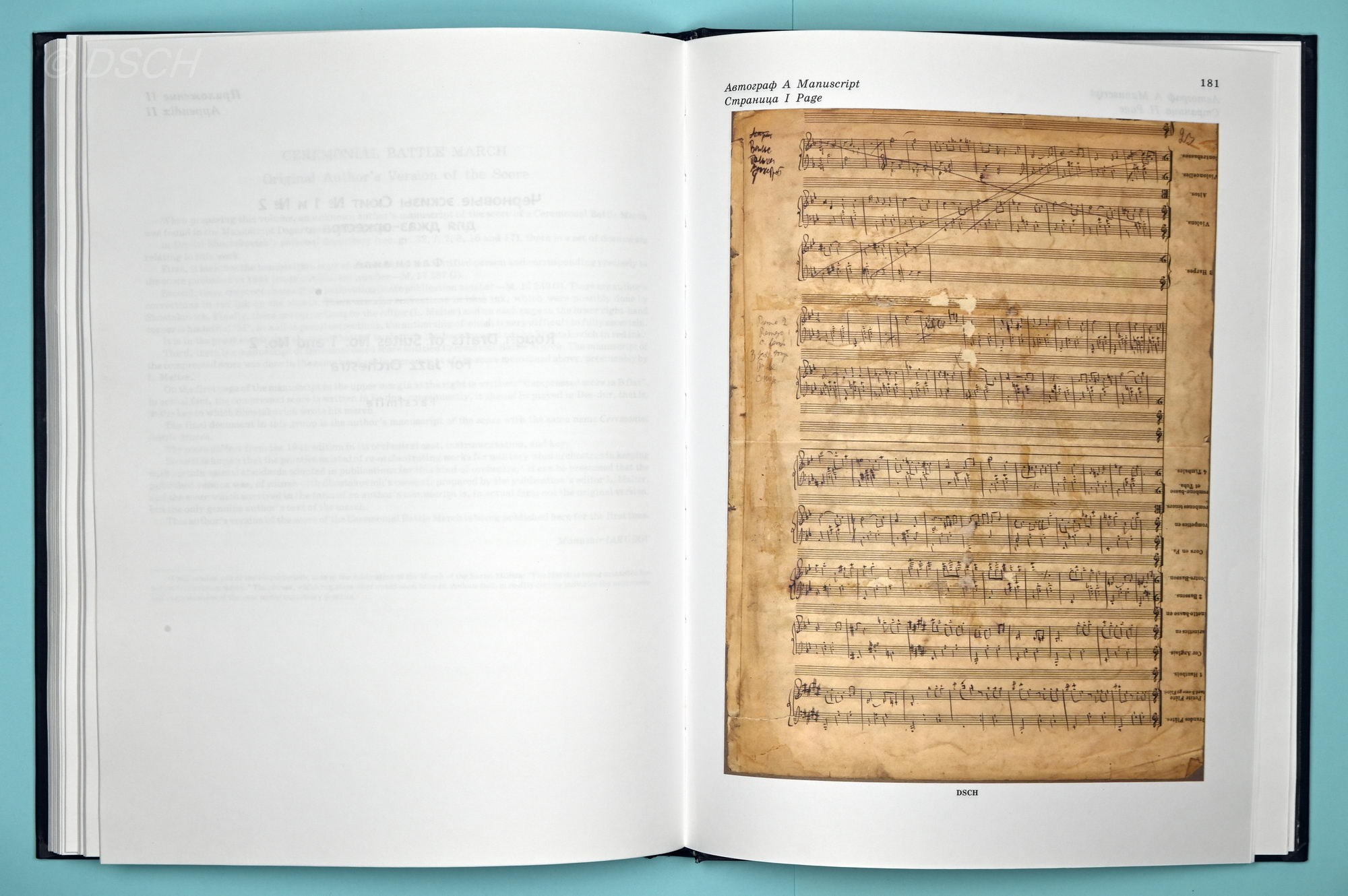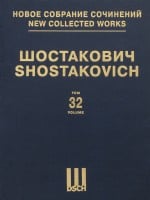Shostakovich, Dmitri - Compositions for Wind Orchestra and Jazz Orchestra - Full Score (New Collected Works vol.32)
Tahiti Trot, Jazz Suites 1 & 2, and others
Instrumentation: (full score) New Collected Works 32
Click below to view music sample pages


Vincent Youmans, “Tahiti Trot”, Orchestral Transcription by Dmitri Shostakovich
The transcription of Vincent Youmans’ (1898-1946) foxtrot, “Tahiti Trot”, is usually dated 1928. Shostakovich himself dated this opus as such in the list of works he compiled at the end of the 1930s.
Instrumentation:
Piccolo, Flauto, 2 Oboi, Clarinetto (B), Fagotto, 4 Corni (F), 2 Trombe (B), Trombone, Timpani, Triangolo, Tamburo, Piatti, Campanelli, Silofono, Celesta, Arpa, Archi
Until recently, the author’s manuscript of the transcription was thought to be lost. In the list of his works compiled at the end of the 1930s, Shostakovich made a note next to the title of this work: “disappeared”. At the beginning of the 1980s, conductor Gennadi Rozhdestvensky was given orchestrated parts of the transcription by Nikolai Malko’s widow and restored the score in correlation to them. This was the form it was printed in for the first time in the Appendix of the tenth volume of Dmitri Shostakovich’s Collected Works (Moscow, 1984). After the publication of Malko’s reminiscences, the existence of the author’s manuscript Shostakovich had given the conductor (for more detail, see my article in this volume) became known, but this author’s manuscript was not available when preparing this volume. The author’s manuscript of “Tahiti Trot” intended for the ballet The Golden Age was found in Dmitri Shostakovich’s Archives. Its comparison with the score restored by Rozhdestvensky showed that the concert and ballet versions are identical. This publication is based on this author’s manuscript (A), but in some cases, the first edition of the score is taken into account.
Two Pieces by Domenico Scarlatti. Transcription for Wind Orchestra
By way of original sources, Shostakovich used two of Scarlatti’s sonatas: d-moll K 9 (L 413) and Es-dur K 20 (L 375).
Instrumentation:
Piccolo, 2 Flauti, 2 Oboi, 2 Clarinetti (B), 2 Fagotti, 2 Corni (F), 2 Trombe (B), Trombone, Timpani
The author’s manuscript of the score has not been found. It is being printed for the first time in correlation with the handwritten copy kept in Dmitri Shostakovich’s Archives.
Suite No. 1 for Jazz Orchestra Sans op. (1934)
Suite No. 1 for Jazz Orchestra in Three Movements was written in 1934. The appearance of this work resulted from Shostakovich’s striving to enlarge the genre range of his creative work. “I have worked in a variety of genres, but there are so many genres I have yet to try!” wrote the composer in January 1934. “I have had a great breakthrough in chamber and chamber-variety music. This happened due to a certain lack of appreciation of these other genres. But time insistently tells me that these genres have a right and are obliged to grow and thrive”.
Instrumentation:
Saxofono soprano (B) = Saxofono alto (Es), Saxofono alto (Es), Saxofono tenore (B), 2 Trombe (B), Trombone, Tamburo, Legno, Campanelli, Silofono, Banjo, Chitarra hawaiana, Piano, Violino, Cotrabasso
Suite No. 2 for Jazz Orchestra Sans op. (1938)
Suite in Three Movements was written in 1938 as ordered by the newly created USSR State Jazz Orchestra.The score and parts of Suite No. 2 for Jazz Orchestra have apparently not survived. In 1999, a rough draft of all three pieces was found in Dmitri Shostakovich’s personal depository in the Glinka State Central Museum of Musical Culture (GSCMMC) among the unidentified author’s manuscripts. The author’s manuscript does not have a general heading, and the pieces are not arranged in it in the order they are in the final version of the composition. The rough drafts found in Dmitri Shostakovich’s personal depository at GSCMMC laid the foundation for this work’s return to the concert stage. In 2000, British composer Gerard McBurney revived and instrumented all three movements of Suite No. 2.
Instrumentation:
2 Saxofoni alti (Es), 2 Saxofoni tenori (Es), Saxofono baritono (Es). 4 Trombe (B), Trombone tenore, Trombone basso, Tuba, Batteria I: Suspend Cymbal, Large suspended Cymbal, Side Drum, Woodblock, Bass Drum, Batteria II: Triangolo, Castagnette, Tam-tam, Campanelli, Flessatono, Silofono, 3 Banjos, 3 Chitarre, Piano, 6 Violini, 2 Contrabassi
Ceremonial March for Wind Orchestra Sans op. (1941)
The Ceremonial March for Wind Orchestra was most likely written at the end of 1940 or the beginning of 1941. We are dating it 1941 based on the date of the censorship permission for the manuscript48: “12 February 1941.” The March was possibly composed on the order of some specific large orchestra which included not only brass, but also woodwind instruments. Shostakovich looked at the possibility of the March being performed by more customary and smaller collectives, stipulating this in a special comment: “The piccolo flute, oboe, bassoon, III and IV French horn and trombone parts are not obligatory.”
Instrumentation:
Piccolo, 2 Oboi, Clarinetto piccolo (Es), 3 Clarinetti (B), 2 Fagotti, 4 Corni (Es), 2 Trombe (B), 3 Tromboni, Tamburo militare, Piatti, Cassa, 2 Cornetti (B), 2 Alti (Es), 3 Tenori (B), Baritone (B), 3 Tromboni, Bassi
The whereabouts of the author’s manuscript of this version of the score is not known. There is a handwritten copy of the score in Dmitri Shostakovich’s personal depository in GSCMMC (rec. gr. 32, f. 7 and 8), in keeping with which the first edition was printed. Before submitting the score for print, Shostakovich crossed out the word “battle” in the title in the proof sheets, probably since it contradicted somewhat the word “ceremonial”. There is also an author's manuscript of the score of a Ceremonial Battle March in a different orchestration in GSCMMC. This version is being published in Appendix I in this volume. The Ceremonial March is being printed in keeping with the first edition put out by State Music Publishers in 1941 in 750 copies.
German March for Wind Orchestra From the Music to the Film Warmongers Sans op. (1950)
The German March was written for the film Warmongers directed by Leo Arnshtam.49 Work on the film came to a halt in 1951. The author’s manuscript of the score of the German March is kept in Dmitri Shostakovich’s Archives, the handwritten copy of the score is in the music library of the State Symphonic Orchestra of Cinematography (No. 397). The author’s manuscript is not dated. In keeping with the time the film was made, it can be presumed that the March was written at the end of 1950. The score of the German March is being published for the first time.
Instrumentation:
2 Piccoli, 2 Flauti, Clarinetto (A), Tamburino, 6 Tamburi militari, 4 Casse
It is being published according to the author's manuscript kept in Dmitri Shostakovich's Archives. The handwritten copy of the score is kept in the Music Library of the Orchestra of Cinematography.
March of the Soviet Militia for Wind Orchestra Op. 139
The March was written in 1970 on the initiative of USSR Minister of Internal Affairs Nikolai Shchelokov, who not only wrote a special letter to the composer on 2 December 1969, but also sent him a photocopy of piano score of “The March of the St. Petersburg Capital Police for its 1703-1903 anniversary. Composed by G. Friderichs” as a “model”. Shostakovich’s work was awarded the first prize at the All-Union Interior Ministry Contest for the best march for a wind orchestra. The statements found in reference books that the March of the Soviet Militia is dedicated to “playwright” Mikhail Mikhailovich Zoshchenko are a misunderstanding. The work does not have any dedication.
Instrumentation:
Flauto, 3 Clarinetti, 2 Cornetti (B), 2 Trombe (B), 3 Corni (F), 2 Alti (Es), 2 Tenori (B), 2 Baritoni (B), Trombone, 2 Bassi, Timpani, Triangolo, Tamburo militare, Piatti
The whereabouts of the author’s manuscript is not known. It is being printed in keeping with the edition of the score in the collection Marches of the Soviet Militia (Muzyka Publishers, Moscow, 1978). The edition was accompanied by the comment: “The March is being printed in the author’s instrumentation.”
This ambitious series by DSCH, the exclusive publisher of the works of Dmitri Shostakovich, when complete, will run to 150 volumes.
Based on authentic manuscripts, accompanied by commentaries in Russian and in English, each volume contains new engravings, articles relating to the history of the compositions, facsimile pages of Shostakovich's manuscripts, outlines, and rough drafts.
Divided into 15 different "series" or genres, the edition will include nearly all the original works of the composer, and his instrumentation of music by Domenico Scarlatti, Beethoven, Schubert, Schumann, Mussorgsky, Rimsky-Korsakov, Johann Strauss, Youmans, Braga, Tishchenko, and others.
25% of the New Collected Works will be made up of previously unpublished material: over 80 of his works are being published here for the first time. Many of these previously unknown works could not be published or performed during the composer's lifetime for ideological reasons.
The fifteen "series" within the edition comprise:
I: Symphonies (vols 1-30)
II: Orchestra Compositions (vols 31-37)
III: Instrumental Concertos (vols 38-49)
IV: Compositions for the Stage (vols 50-67)
V: Suites from Operas and Ballets (vols 68-72)
VI: Compositions for Choir and Orchestra (With or Without Soloists) (vols 73-83)
VII: Unaccompanied Choral Compositions/Arrangements of Russian Folksongs (vols 84-86)
VIII: Compositions for Solo Voice(S) With Orchestra (vols 87-90)
IX: Chamber Compositions for Voice and Songs (vols 91-97)
X: Chamber Instrumental Ensembles (vols 98-105)
XI: Instrumental Sonatas(vols 106-108)
XII: Piano Compositions (vols 109-115)
XIII: Incidental Music (vols 116-121)
XIV: Film Music (vols 122-145)
XV: The Works of Other Composers, Instrumentation by Shostakovich (vols 146-150)
Contents |
|
| 01 Tahiti Trot, op.16 (Transcription of Vincent Youmans' Song for Orchestra) | |
| 02 Two Pieces by Domenico Scarlatti, op. 17 (Transcription for Wind Orchestra) | |
| 03 Suite No. 1 for Jazz Orchestra, o. op. | |
| 04 Suite No. 2 for Jazz Orchestra, o. op. | |
| 05 Ceremonial March for Wind Orchestra, o. op. | |
| 06 German March for Wind Orchestra, o. op. | |
| 07 March for the Soviet Militia for Wind Orchestra, op. 139 | |

